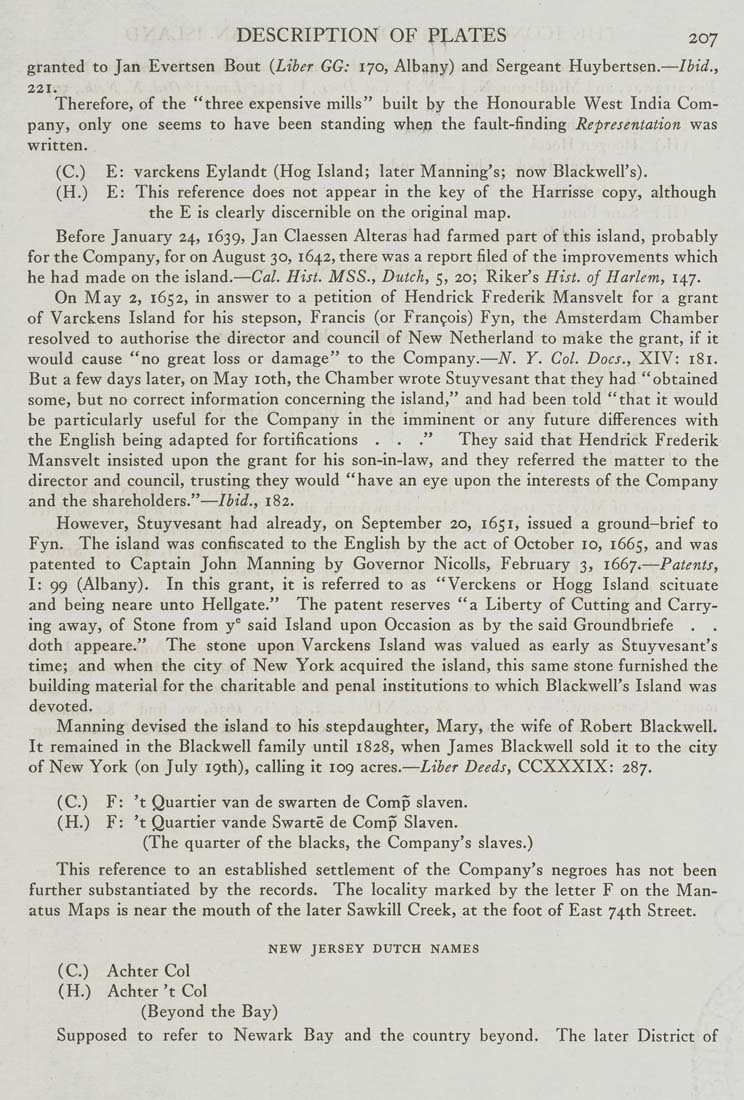DESCRIPTION OF PLATES 207
granted to Jan Evertsen Bout {Liber GG: 170, Albany) and Sergeant Huybertsen.—Ibid.,
221.
Therefore, of the "three expensive mills" built by the Honourable West India Com¬
pany, only one seems to have been standing when the fault-finding Representation was
written.
(C.) E: varckens Eylandt (Hog Island; later Manning's; now Blackwell's).
(H.) E: This reference does not appear in the key of the Harrisse copy, although
the E is clearly discernible on the original map.
Before January 24, 1639, Jan Claessen Alteras had farmed part of this island, probably
for the Company, for on August 30, 1642, there was a report filed of the improvements which
he had made on the island.—Cal. Hist. MSS., Dutch, 5, 20; Riker's Hist, of Harlem, 147.
On May 2, 1652, in answer to a petition of Hendrick Frederik Mansvelt for a grant
of Varckens Island for his stepson, Francis (or Francois) Fyn, the Amsterdam Chamber
resolved to authorise the director and council of New Netherland to make the grant, if it
would cause "no great loss or damage" to the Company.—A'^. Y. Col. Docs., XIV: 181.
But a few days later, on May loth, the Chamber wrote Stuyvesant that they had "obtained
some, but no correct information concerning the island," and had been told "that it would
be particularly useful for the Company in the imminent or any future differences with
the English being adapted for fortifications . . ." They said that Hendrick Frederik
Mansvelt insisted upon the grant for his son-in-law, and they referred the matter to the
director and council, trusting they would "have an eye upon the interests of the Company
and the shareholders."—Ibid., 182.
However, Stuyvesant had already, on September 20, 1651, issued a ground-brief to
Fyn. The island was confiscated to the English by the act of October 10, 1665, and was
patented to Captain John Manning by Governor Nicolls, February 3, 1667.—Patents,
I: 99 (Albany). In this grant, it is referred to as "Verckens or Hogg Island scituate
and being neare unto Hellgate." The patent reserves "a Liberty of Cutting and Carry¬
ing away, of Stone from y° said Island upon Occasion as by the said Groundbriefe . .
doth appeare." The stone upon Varckens Island was valued as early as Stuyvesant's
time; and when the city of New York acquired the island, this same stone furnished the
building material for the charitable and penal institutions to which Blackwell's Island was
devoted.
Manning devised the island to his stepdaughter, Mary, the wife of Robert Blackwell.
It remained in the Blackwell family until 1828, when James Blackwell sold it to the city
of New York (on July 19th), calling it 109 acres.—Liber Deeds, CCXXXIX: 287.
(C.) F: 't Quartier van de swarten de Comp slaven.
(H.) F; 't Quartier vande Swarte de Comp Slaven.
(The quarter of the blacks, the Company's slaves.)
This reference to an established settlement of the Company's negroes has not been
further substantiated by the records. The locality marked by the letter F on the Man¬
atus Maps is near the mouth of the later Sawkill Creek, at the foot of East 74th Street.
NEW JERSEY DUTCH NAMES
(C.) Achter Col
(H.) Achter't Col
(Beyond the Bay)
Supposed to refer to Newark Bay and the country beyond. The later District of
|








